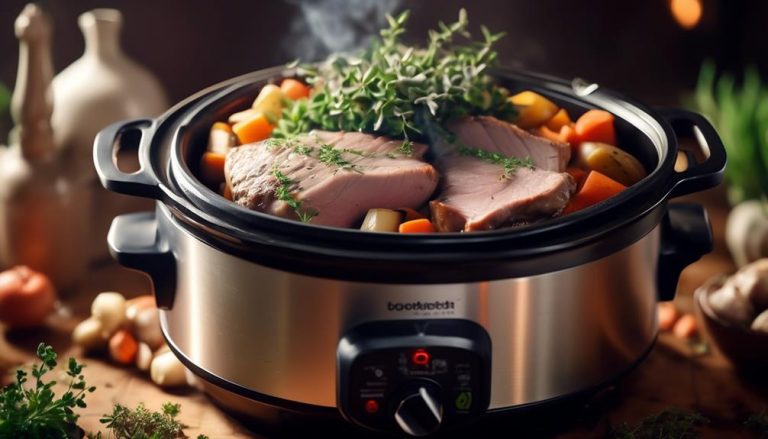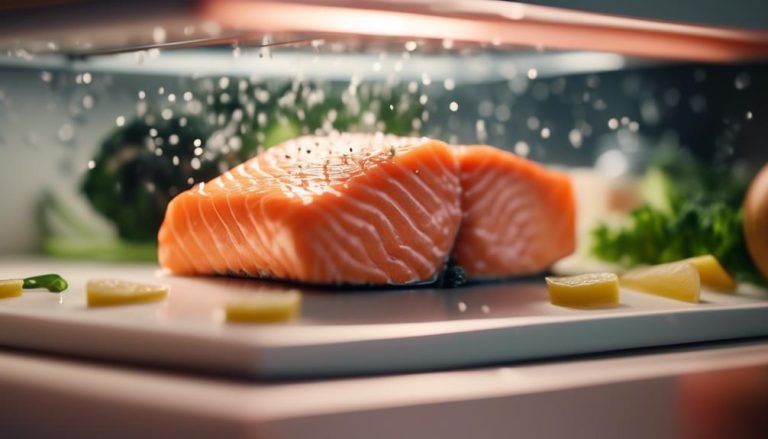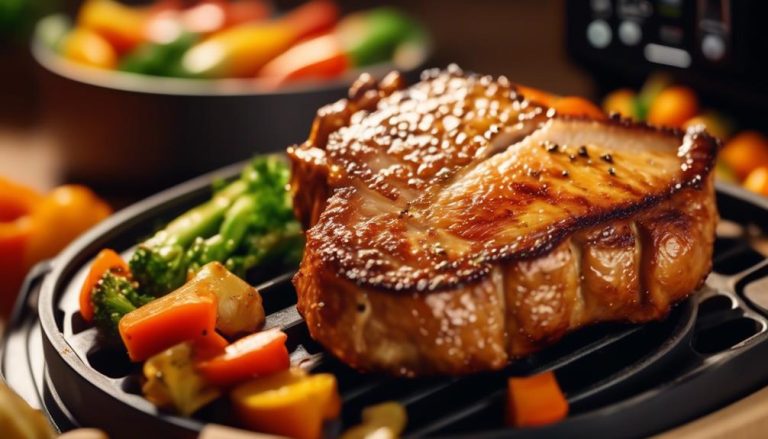Veal Vs Beef Taste: What Is The Differences Between
Veal vs beef taste has been debated by food enthusiasts.

The tastes of these two meats differ significantly in various ways due to factors such as their age, diet, cognitive development, and muscle development.
We’ve got the scoop into the fundamental differences between veal and beef. Plus providing insights into their respective tastes and applications in various dishes.
Types of Meats
Coming from young calves, the flavor of veal is the mildest flavor and has a more neutral flavor profile compared to beef, which originates from mature cows.
This difference in flavor intensity can influence the preparation methods and flavor pairings for each meat.
The term veal means “of a young calf” and as for the history of veal, it originated in ancient European times like Ancient Rome.
Veal can be found in a butcher shop and Italian restaurant. It is commonly used in French cuisines and Mediterranean cuisines
Furthermore, veal is often described as having a more tender texture and melt-in-your-mouth.
Which is attributable to the muscle development of younger animals. While beef presents a robust and hearty sensation to the palate.
It is important to note that since veal is tender, it’s absorbed in the digestive tract more easily.
By understanding the unique characteristics of each meat and the different ways they can taste, culinary enthusiasts can make informed decisions about which to use in their recipes.
Veal is sometimes referred to as the chicken of red meats because of how lean it is.
Whether you prefer the subtle, tender taste of veal or the unmistakable, rich flavor of beef, both meats offer versatility and endless opportunities for culinary exploration.
Veal and Beef: Overview

Defining Veal
Veal is a type of meat that comes from young calves. Specifically those that are between 5 days old and 35 weeks of age.
The color of the meat is commonly lighter in color, with a pinkish hue. The flavor of veal is described as a unique mild and subtle flavor.
Veal is often classified into various categories based on the age of the animal when slaughtered, including bob, formula-fed veal, rose, and grain-fed veal.
Compared to beef, veal has less cholesterol levels, making it a healthier option for some individuals.
Defining Beef
On the other hand, beef is the meat obtained from adult cows, typically older than one year.
This is a good source of protein and has a strong, robust taste featuring a distinct, dark brownish color.
Beef is known for its marbling, which is the distribution of fat within the meat. Gving it a rich, fatty flavor that is absent in veal.
Due to the mature musculature in adult cattle, beef has a denser texture compared to veal. Making it a more versatile meat option for various culinary dishes.
Both veal and beef are types of meat that come from different stages of the bovine meat life cycle. Derived from young calves, veal taste like lighter in flavor and more tender in texture.
Conversely, beef, which originates from adult cattle, offers a stronger taste and denser texture best suited for a variety of meals.
Taste and Texture Differences

Taste Profiles of Veal and Beef
Veal and beef are derived from the same animal, but they have different taste profiles.
Veal comes from young cows, like a male calf or sometimes female calves, which means its flavor is milder and more delicate than beef.
This is because veal is typically raised on a milk-based diet, which contributes to its distinctive taste. Whereas beef is raised on open fields or green pastures diet.
On the other hand, a great way to determine the main difference is that beef has a bolder, sharper flavor as it comes from older cattle.
The age of the animal being eaten also plays a role in the taste difference.
For instance, younger animals generally have subtler flavors and tender textures compared to older ones.
Texture Comparison
When it comes to texture, veal is known for its delicate and softer texture, with a fine-grained and firm structure.
The meat’s pale color and velvety texture make it a popular choice in various cuisines for its elegant appearance.
Beef, however, has a denser and tougher texture. As the animal ages, the muscle fibers become more pronounced, resulting in a chewier meat.
Additionally, types of beef have a dark red color and typically contain more marbling, or intramuscular fat, compared to veal.
This marbling leads to a juicier and more flavorful beef. Both veal and beef have unique taste profiles and textures.
Veal is more delicate, tender, and has a mild flavor, while beef has a bolder taste and a denser texture.
Types and Cuts of Veal and Beef

Types of Veal
There are different types of veal, each categorized by the age of the calf when it is slaughtered. The most common types are:
- Bob veal: Calves slaughtered at 1-3 weeks old; their meat is paler and milder in flavor.
- Milk-fed veal: Calves fed only milk for 4-5 months before slaughter; the white veal meat is tender and off-white to pale pink in color.
- Rose veal: Calves raised on a diet of milk and solid food for 6-8 months; the meat is pinkish with a slightly darker hue than milk-fed veal and has a richer flavor.
- Red veal: Calves fed a diet similar to beef cattle, resulting in darker red meat with a more beef-like flavor.
Some traditional Italian dishes often use veal as the main protein, offering a more tender and mild alternative to beef.
Cut of Veal
Veal is available in different cuts, including:
- Veal chop: A cut from the rib or loin; ideal for pan-frying or grilling.
- Veal shank: A portion of the leg, typically slow-cooked in dishes like osso buco.
- Veal roast: A large cut from the rib chop, loin chop, veal chop or shoulder, often oven-roasted.
Cut of Beef

Similar to veal, regular beef is available in various cut of of meat originating from different parts of the animal, such as:
- Rib: Includes ribeye steaks, short ribs, and prime rib; known for its marbling and tenderness.
- Loin: Contains cuts like porterhouse, T-bone, and tenderloin steaks; prized for its tenderness and flavor.
- Round: Comes from the rear leg and includes cuts like top round, bottom round, and eye of round; lean meat and best for roasting or braising.
- Chuck: From the upper shoulder, chuck cuts include roasts, short ribs, and ground beef; best for slow cooking methods.
- Brisket: The lower chest area of the animal; typically used for slow cooking methods, such as smoking or braising.
Both veal and beef have distinct flavors and textures depending on their specific cuts and the age of the calves when slaughtered.
With careful preparation, each can shine in a variety of dishes, from traditional Italian plates to hearty roasts or flavorful burgers.
Nutritional Value Comparison

Calories
When comparing veal and beef, there is a difference in calorie content.
85 grams of beef contains 213 calories, while 100 grams of veal has 146 calories. This makes veal the leaner option of the two.
Fat and Cholesterol
Veal and beef also have different fat contents.
A 3-ounce (84 grams) portion of rib roast veal contains 12 grams of total fat and 4.5 grams of saturated fat. This shows that there is lower fat content in veal compared to regular beef.
Veal contains more unsaturated fatty acids and beef contains more saturated fat.
In terms of cholesterol, both veal and beef share similar amounts of milligrams of cholesterol, despite the differences in fat content.
Vitamins
There are some variations in vitamin content between veal and beef.
Veal is typically higher in vitamin E, whereas beef contains more vitamin A and vitamin B, such as vitamin B12.
The amounts of vitamin Bs or B vitamins, like vitamin B6 and K are almost the same in both types of meat. Neither contain any significant amounts of vitamin C or D.
Minerals and Other Nutrients
Beef is denser in daily value nutrients overall, consisting of 58% water, whereas veal contains 67% water.
Both veal and beef are good sources of minerals like iron, zinc, magnesium, and calcium.
However, veal has slightly higher amounts of some minerals like iron, while beef has more zinc.
For proper function in our immune system, zinc is needed and red meat contains one of the highest sources of zinc.
In terms of other nutrients, a 3-ounce piece of beef contains 3.196 milligrams of niacin, while veal has 0.867 milligrams of pantothenic acid.
The amounts of sodium in both meats are comparable, making them suitable options for those watching their salt intake.
Cooking Techniques and Dishes

Comparing Cooking Methods
When it comes to cooking veal and beef, a variety of ways and different techniques can play a significant role in enhancing their flavors.
Veal has a more delicate flavor and is considered easier to digest than beef, making certain cooking methods more suitable for its preparation.
Veal is often made in traditional French dinner dishes, taking advantage of its tender texture.
One popular cooking method for veal is frying, as seen with breaded veal cutlets.
To cook veal cutlets, use the most popular ingredients and a three-step breading process: flour, egg, then breadcrumbs, and then pan-fry until golden and crisp on the outside.
Another method is slow-cooking milk-fed veal with lemon, which further contributes to its tender texture and lighter flavor.
Additionally, veal parmesan is also a popular recipe that people like to cook using ground veal and parmesan cheese baked in marinara sauce.
While beef can be prepared in multiple methods like grilling, roasting, and pan-searing, it’s important to note that aged beef is best suited for rare or medium-rare cooking, as this retains the meat’s natural juices and unique taste.
Beef is an excellent source of protein and also tends to be more versatile than veal and can be enjoyed ground in dishes like burgers or tacos.
Popular Veal and Beef Dishes
Veal and beef dishes vary considerably due to their distinct tastes and textures. Here are some popular dishes for both types of popular meats:
Veal:
- Osso Buco: Slow-cooked veal shanks with vegetables, white wine, and broth
- Saltimbocca: Thin veal cutlets wrapped with prosciutto and sage and pan-fried
- Veal Piccata: Pan-fried veal cutlets in olive oil on high heat with a lemon and caper sauce
Beef:
- Beef Bourguignon: Slow-cooked stew made with beef, red wine, mushrooms, and onions
- Steak au Poivre: Pepper-crusted pan-seared steaks with a creamy cognac sauce
- Beef Wellington: Beef tenderloin coated in mushroom duxelles, wrapped in puff pastry, and baked
Veal and beef dishes have unique flavors, textures, and cooking techniques that cater to various palates.
They both have a range of popular dishes stemming from traditional culinary cultures, with veal often favored for its delicate flavor and beef for its robust taste.
Meat Production and Classification

Production of Veal Process
Veal is the meat of calves, in contrast to beef, which is from the meat of cattle that are older.
Veal can be produced from young animals at a young age, more specifically, a calf of either sex and any breed.
However, most veal comes from young male calves of dairy products breeds which are not used for breeding purposes.
Male dairy calves are used in the veal industry as dairy cows must give birth to continue producing milk, but the male dairy calves hold little value for dairy farmers otherwise.
Veal calves are raised until about 16 to 18 weeks of age, weighing up to 450 pounds.
A popular type of veal, which is a common ingredient in French cuisine, is milk-fed veal, where calves are primarily fed with a milk-based diet to achieve a pale and delicately textured meat.
Beef Production Process

Beef, on the other hand, comes from the bovine species of cows and beef cattle that are older than the veal calves.
The age of the animal greatly influences the taste and texture of the meat.
For instance, beef is generally stronger in flavor and firmer in texture compared to veal.
The marbling within the meat is also different, contributing to the overall taste and characteristics of beef.
These differences in taste and texture between veal and beef can be attributed to factors such as:
- Age: Veal is younger than beef, resulting in a more delicate and tender meat.
- Diet: Milk-fed veal has a paler appearance due to its milk-based diet.
- Minerals: Veal contains lower amounts of minerals like phosphorus, whereas beef is richer in these nutrients.
Beef dishes, such as steak, are popular in many cultures and can be served with a variety of side dishes like potatoes, vegetables, and even accompanied with pan-seared chicken liver.
Providing the consumer with a well-rounded culinary experience.
In terms of classification, the type of meat is determined first, either beef, veal, or calf, followed by sex classification, which is more important in beef than veal meat production.
Generally, veal is more expensive by weight than beef from older cattle due to its production process and the characteristics it offers.
If you are curious about how the taste of lamb and veal differ, lamb comes from young sheep and has a more intense gamey taste compared to veal.
Final Thoughts

When comparing the taste of veal to beef, it is important to consider various factors such as the cut of meat, veal production methods, and the texture of veal.
Veal chops, known for their tenderness, offer a delicate and subtle flavor that differs from the robust taste of beef.
The texture of veal is often described as more tender and smooth compared to beef.
Additionally, the diet of grain-fed veal contributes to its flavor profile, imparting a milder taste compared to grass-fed beef.
While both veal and beef are excellent sources of protein and provide essential vitamins B, the choice between the two ultimately depends on personal preference and the desired flavor experience.
It is worth noting that lamb meat, known for its distinct flavor, offers yet another alternative for those seeking a unique taste in their culinary endeavors.

Get the scoop on more like this:






